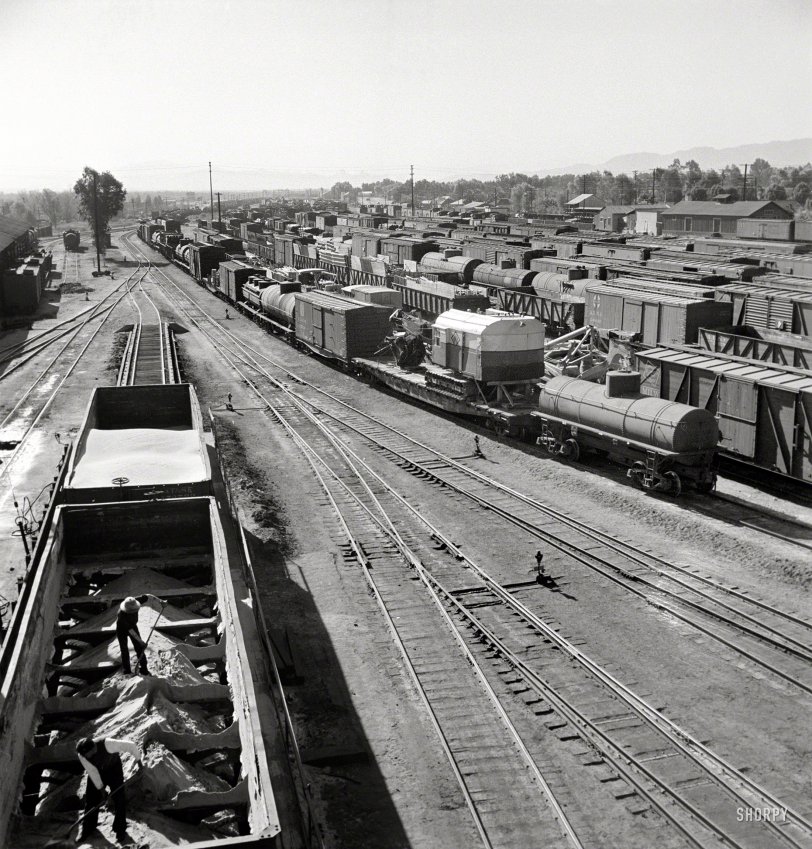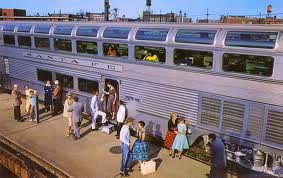


Framed or unframed, desk size to sofa size, printed by us in Arizona and Alabama since 2007. Explore now.
Shorpy is funded by you. Patreon contributors get an ad-free experience.
Learn more.

- Exclusive pump
- Details, Details
- What's that building to the left of the tower?
- Coal Barges
- Bromo-Seltzer
- Inner harbor
- The Basin
- What a headache!
- Giant stepladder?
- Baldwin 62303
- Baldwin VO-1000
- Cold
- No expense spared
- Tough Guys
- Lost in Toyland
- And without gloves
- If I were a blindfolded time traveler
- Smoke Consumer Also Cooks
- Oh that stove!
- Possibly still there?
- What?!?
- $100 Reward
- Freeze Frame
- Texas Flyer wanted
- Just a Year Too Soon
- WWII -- Replacing men with women at the railroad crossing.
- Yes, Icing
- You kids drive me nuts!
- NOT An Easy Job
- I wonder
Print Emporium
Needles: 1943

March 1943. "Needles, California. A general view of the Atchison, Topeka & Santa Fe rail yard." Photo by Jack Delano, Office of War Information. View full size.
Earth moving equipment
Somewhere in my emails there was a picture of a coastal gun being delivered on the West Coast during WWII. It showed the gun and earth moving equipment like the one in the above picture. Note that the shovel has loose cables and there is a bulldozer and scraper on the other track. Also look at the lumber in the gondolas. This must have been some sort of construction going on a short distance away, not an interchange move.
The Santa Fe Passenger cars
Santa Fe introduced the El Capitan train Chicago to Los Angeles long before double stack intermodals. The El Capitan was the precusor of Amtrak's western route cars.

Herr Hitler
You think that you can defeat this country? Just try.
How High?
Marmarinou wonders about vertical clearances on the Santa Fe Railroad. Especially on the main lines, they were so generous that some tall steam engines had retractable smoke stacks that only had to be lowered to clear the engine house doorway! That line was an early route of double stacked intermodal containers.
Can you say HOT?
I spent a long month in Needles one summer day. Seared in my memory. Pun intended.
More About Locomotive Sand
Dash Riprock's comments about sand being used in locomotives, including the present day diesels, leaves out one of the more important reasons those men are shoveling the sand. The sand they are shoveling is wet and before it is deposited into the locomotive, it must be totally dry.
When I worked on the railroad, we had a large gas fired stove with a hopper on the top. Men hand shoveled sand 24 hours per day from a bin into the top of the stove. As the sand dried it dropped by gravity into a bin below the floor. Then the dried sand was blown by compressed air into hoppers high above the locomotives, where it fell by gravity into the locomotive.
The intense sand blasting that the stove received every day meant that the life expectancy of a stove was only a few months before it had to be replaced. That was about an eight hour job, as I recall.
Today, pre-dried sand arrives in hopper trucks and hopper rail cars and is blown directly into the locomotive using compressed air.
Lima shovel, UTLX tank car
Many interesting bits of equipment in this photo - the Lima shovel is perhaps a model 404? Lima Locomotive Works were one of the big three US loco builders, but it was their Shovel & Crane Division that kept the company going during the 1930s.
The tank car next to the shovel is also interesting. A Union Tank Car narrow frame car, these dated back to 1907/08. They were the predecessor of UTLX's well-known Type V or 'Van Dyke' frameless cars. There's also a smallish 3-dome tank car further along the cut, which I'd love to see more of.
Apart from using sand to improve adhesion, oil-burning steam locos also used sand to clean out accumulated soot from the tubes and flues. Typically there would be a small container of sand carried on the front of the tender, so the fireman could scoop sand from it and throw it into the firebox through the peephole.
As usual
Delano hits another grand slam. There’s a lot in this picture to study: the pole lines and signal bridge in the distance, numerous switches, what appears to be a track full of cabooses over yonder, the two guys laboring in the sand…among other things.
One has to wonder which way the Lima power shovel (diesel by all appearances) is going. The sheet metal shows some signs of wear suggesting she’s not new. The routing card would tell us if we had super duper resolution. Before IBM and RFID technology each railcar had a hand written card stapled to it (visible on the shovel and four cars it’s coupled to) indicating either it’s online (not the internet kind…) destination or off going junction, with successive interchange points and carriers listed. As well, a waybill followed the car wherever it went, usually in the possession of the brains…I mean conductor.
We used to call a yard plugged like this “straight across,” the only way in being by parachute. Of course WW 2 was in progress and I’m sure that alone accounted for much of the traffic.
Speaking of shovels
Speaking of shovels, that excavator (I would have called it a "steam shovel" as a kid) on the flat car really adds uniqueness to this photo. It seems to be higher than anything else in the yard. I wonder how high was the limit for rolling stock on this line?
Shovellin' Sand
It looks like the two laborers in the gondola car in the foreground are emptying sand that will be used in the locomotives. This is put into a sand hopper and dribbled onto the track to provide traction when rails are wet or a combination of weight and grade are causing the drivers to slip. I'll wager that this photo was taken from the top of the sand tower, which is used to load this material into the locomotives.
Unless a lot has changed in railway technology in just the last few years, diesel-electric engines still use sand for this purpose.
























On Shorpy:
Today’s Top 5